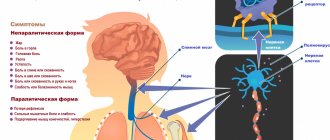Poliomyelitis is a highly contagious viral disease that causes paralysis of the arms, legs, and breathing, and can also cause death. Poliomyelitis pathogens penetrate the oral mucosa mainly through contaminated water. Infection by airborne droplets is also possible.
Poor hygiene conditions favor transmission. The incubation period ranges from 3 to 35 days. After a person gets sick, he develops lifelong immunity (protection against infection) to one viral type (but there are polioviruses types 1, 2 and 3). Only vaccination completely protects against infections of all three types. You can get vaccinated against polio at the RebenOK clinic at the best prices in Moscow.
Why is polio dangerous?
Most infections (>95%) are asymptomatic, but antibodies are produced. If there are signs of illness, there are different pictures of the disease:
· Abortive polio: inflammation of the gastrointestinal tract (gastroenteritis), fever, nausea, sore throat, muscle pain and headaches without central nervous system involvement.
· Non-paralytic poliomyelitis (aseptic meningitis): inflammation of the meninges without paralysis.
· Paralytic polio (1 in 200 infections) with typical symptoms of paralysis: independent breathing may become impossible and lifelong use of mechanical ventilation may be required. Paralysis can also lead to death.
Even decades after infection, post-poliotic syndrome may occur. There is no cure for polio. Only symptomatic therapy is prescribed to eliminate discomfort.
Types of infection
The following forms of polio are distinguished:
Type:
1. Typical poliomyelitis with damage to the central nervous system:
- non-paralytic: meningeal and abortive;
- paralytic: spinal and bulbar;
2. Atypical forms - erased and asymptomatic.
3. By severity:
- light;
- moderate severity;
- heavy.
To establish the degree of severity, the severity of intoxication and movement disorders are assessed.
4. By character:
- smooth course (without complications);
- unsmooth course (with complications, with the addition of a secondary infection, with exacerbation of chronic diseases).
Types of vaccines
Various vaccines are available, which are administered by a doctor using a syringe in several single doses. Polio vaccination for infants is often combined with other vaccines. The combination vaccine is distributed over four single doses: the first is given to infants at the age of 3 months, the last - in the second year of life.
Types of polio vaccines:
· Vaccination with OPV (oral polio vaccine).
It comes in the form of drops and contains weakened forms of two types of viruses. Passive immunity is produced in the intestines.
· Vaccination IPV (inactivated vaccine).
It has the form of a homogeneous suspension, available in disposable 0.5 ml syringes. It contains three types of “dead” viruses.
OPV is cheaper. The drug is produced in Russia and has good reviews. Inactivated polio vaccine is an imported product. The drugs have certain differences and have their own side effects and positive aspects.
The RebenOK clinic uses several drugs. Names of the polio vaccine:
· "Pentaxim". Designed for children from three months of age. The national vaccination schedule involves three injections with an interval of one and a half months and further revaccination after a year. The second revaccination (fifth administration of the drug) is carried out with OPV or IPV.
· "Bivouac Polio". Live polio vaccine, which consists of three doses of a weakened oral vaccine and two doses of an inactivated vaccine. It is carried out in the first year of life. Booster vaccination against polio is carried out one year after receiving the first dose.
· "Infarix Hexa". A combined drug that does not have strict preparation requirements. The vaccine is effective against polio, tetanus, diphtheria, whooping cough, Haemophilus influenzae, and hepatitis B.
· "Polimilex". A single drug that is widely used for the prevention of polio. Injected subcutaneously or intramuscularly. The drug is “dead”, so it cannot cause the development of the disease.
The choice of drug remains with the doctor. Many experts prefer to use combination vaccines. If a child has contraindications, then single medications are prescribed.
Vaccine options
The development of effective vaccines to prevent paralytic polio was one of the greatest medical advances of the 20th century.
Today there are two types of vaccines against this disease. Inactivated polio vaccine (IPV), which contains killed poliovirus, is administered intramuscularly. Oral polio vaccine (OPV), which contains a weakened live poliovirus, is given by mouth. It is the most commonly used polio vaccine today. Vaccines can be divided into types. As a result of the development and evaluation of the bivalent oral polio vaccine in 2009, the Global Polio Eradication Initiative now has an arsenal of 5 different vaccines to stop polio transmission:
- oral polio vaccine (OPV);
- monovalent oral polio vaccine (mOPV1 and mOPV3);
- bivalent oral polio vaccine (bOPV);
- inactivated polio vaccine (IPV).
In Russia, until April 2021, the following mono- and combined vaccines were used to prevent polio: mono vaccines - oral polio types 1, 2, 3, Imovax Polio, Poliorix; combination vaccines - Infanrix Penta, Infanrix Hexa, Pentaxim, Tetraxim.
In April 2021, OPV containing Sabin strains 1, 2 and 3 was destroyed in accordance with the WHO Global Polio Eradication Initiative.
Advantages and disadvantages
Polio vaccination is usually given in infancy as part of basic immunization, along with the other five routine vaccinations. Poliomyelitis is a serious infectious disease, which in its development stage leads to disability if the gray matter of the spinal cord is damaged. Benefits of polio vaccination:
· allows you to avoid infection and prevent disability, skeletal deformities and paralysis;
· the vaccinated person develops immunity from the disease, so even if infected, the child will tolerate the disease much easier;
· Adverse reactions after vaccination are mostly absent.
Many believe that the vaccine has shortcomings that result in the development of the disease polio. But the probability of such an outcome is no more than 1 case in 2.7 million people.
Vaccination is not dangerous to the life and health of the child. The goal is to protect against future infection by creating a barrier against infection. The most harmless is the inactive vaccine.
Vaccine effectiveness
The introduction of vaccines that prevent polio into practice led to a rapid decrease in incidence, and in many territories to its almost complete elimination (for example, in the USSR since 1961). (Incidence fell from 22,000 cases to 4,000 cases in 1961; since 1962, no more than 100-150 cases have been reported per year, many of which may have been caused by other enteroviruses).
Since 1988, the number of polio cases worldwide has decreased by more than 99%, from an estimated 350,000 to 73 cases reported in 2015. This decrease was the result of global efforts to eradicate the disease. The polio vaccine forms long-term immunity to the virus of all types in 95% of those vaccinated after the first course of vaccination (three vaccinations).
Some countries have switched to inactivated polio vaccine only due to progress towards polio eradication (as the risk of wild poliovirus has decreased). But most countries use OPV because it has the unique ability to induce local gut immunity, meaning it can interrupt transmission of wild poliovirus in the natural environment. This is not possible with IPV, an inactivated polio vaccine that stimulates low levels of immunity against poliovirus in the intestine, resulting in individual protection against polio, but unlike OPV, it cannot prevent the spread of wild poliovirus. IPV is recommended for patients with immunodeficiency, HIV-infected people, as well as those whose families have such patients.
Adverse reactions
The combination polio vaccine, often used in infants, is generally well tolerated. There may be redness or painful swelling at the injection site. Allergic reactions are also possible.
As the immune system reacts to the vaccine, it may temporarily cause various illnesses. These include, for example:
· headaches and aches;
· gastrointestinal discomfort;
· fever and fatigue;
· irritability and chills.
These vaccination reactions usually resolve on their own within 1-3 days.
Diagnostics
When making a diagnosis, clinical, epidemiological, serological and virological data should be taken into account:
- spinal puncture (increased pressure of cerebrospinal fluid, leukocytes - neutrophils, increased protein content);
- general blood test (signs of inflammation: leukocytosis, increased ESR);
- throat washes and culture on a nutrient medium;
- fecal analysis with culture;
- culture of blood and CSF on a nutrient medium;
- determination of antibodies in blood serum (no less than a fourfold increase in antibody titers in paired sera taken in the acute stage of the disease and after 1–3 weeks);
- electroencephalogram and MRI (give nonspecific results and are only of relative importance for diagnosis).
Is there a fever after vaccination?
Children may develop a fever after receiving the polio vaccine. This reaction is considered normal and indicates that the body has begun to produce antibodies necessary to fight the virus. A slight increase in body temperature is observed in 1-4% of patients. The temperature may rise to 37.5-38.6 degrees. If the readings exceed a moderate level, then you should take an antipyretic drug.
How many vaccinations are given against polio?
The Russian national vaccination calendar provides the following polio vaccination schedule:
· in the 1st year of life – at 3,4,5 and 6 months;
· in the 2nd year of life – at 18 and 20 months;
· at the age of 14 – once.
In accordance with the Russian calendar, the first two vaccinations are carried out with IPV, the third – with OPV. The vaccination course involves the use of only inactivated vaccines. When two doses of OPV are administered, it is possible to provide high local protection in the intestine. With continued use of live vaccines, the risk of developing vaccine-associated poliomyelitis is reduced.
Principles and purposes of vaccination
Polio is a serious disease that affects the nervous system and can lead to paralysis in a matter of hours. Poliomyelitis is incurable, it can only be prevented. When given repeatedly, the polio vaccine can protect a child for life.
Vaccination against polio is carried out everywhere. According to the National Vaccination Calendar of the Russian Federation, the first two vaccinations are carried out with IPV, the third and subsequent revaccinations are carried out with OPV. In addition to vaccination and revaccination of children, revaccination of adults is carried out if they travel to areas dangerous for polio.
Currently, under the auspices of WHO, a program to eradicate polio from the Earth is being implemented. Russia is certified as a country free from wild poliovirus. But as long as there is at least one infected child in the world, children in all countries are at risk of contracting polio.
Failure to eradicate polio from these remaining persistent foci could result in up to 200,000 new cases of the disease occurring annually worldwide within 10 years.
Tips for parents
If a child often has allergic reactions or is allergic, then vaccination is possible only during the period of remission. There is no need to use any medications before administering the vaccine.
If your child experiences the following symptoms after vaccination, you should consult a doctor:
· appearance of signs of acute respiratory infections (runny nose, cough, etc.);
· dysfunction of the gastrointestinal tract;
· shortness of breath, decreased muscle tone of the limbs.
We are talking about signs of vaccine-associated polio, which may appear 4-30 days after OPV administration. A visit to the pediatrician is necessary if there is an irregular heartbeat, urticaria or severe headaches.
After vaccination, it is recommended to avoid visiting crowded places. The child should be given more purified water to drink, and allergenic foods should be excluded from the diet.
Treatment of polio
Treatment of polio is carried out by an infectious disease specialist in a hospital setting.
Patients are isolated in a box for 40 days.
There is no specific treatment against the disease -
- symptomatic therapy is carried out (antipyretics, painkillers, sedatives),
- gammaglobulin and vitamin therapy (vitamins C, B1, B 12, B6), amino acids are prescribed.
Patients in the acute stage of the disease are prescribed strict bed rest (2-3 weeks). In case of paralysis of the respiratory muscles - artificial ventilation.
Paralyzed limbs require special attention. The positions of the legs, arms and spine must be correct. The legs are laid parallel, slightly bent at the knee and hip joints using pads. The feet should be perpendicular to the shins (they are fixed by placing a thick pillow under the soles). The arms are spread to the sides and bent at the elbow joints at an angle of 90°.
To improve neuromuscular conduction, prozerin, neuromidin, and dibazol are prescribed. Treatment in the infectious diseases department takes 3-4 weeks.
Rehabilitation treatment begins in the hospital and continues on an outpatient basis. Physical therapy is prescribed, classes are held with an orthopedist, water procedures (exercises under water), physiotherapy (UHF, electrical stimulation, applying hot wet compresses to sore muscles). In the future, sanatorium-resort treatment (sea, sulfur baths, mud) is indicated.
Warning for the unvaccinated
The stated goal of the World Health Organization (WHO) is to eradicate polio, and Russia is also committed to this goal. However, polio is still found in Pakistan, Afghanistan or Nigeria and can also be carried by tourists into the Russian Federation. Therefore, polio vaccination is still recommended, important and necessary.
Everyone should be vaccinated against polio, ideally as early as infancy. People who were not vaccinated as children, or whose vaccination status is unknown, should catch up on polio vaccination.










